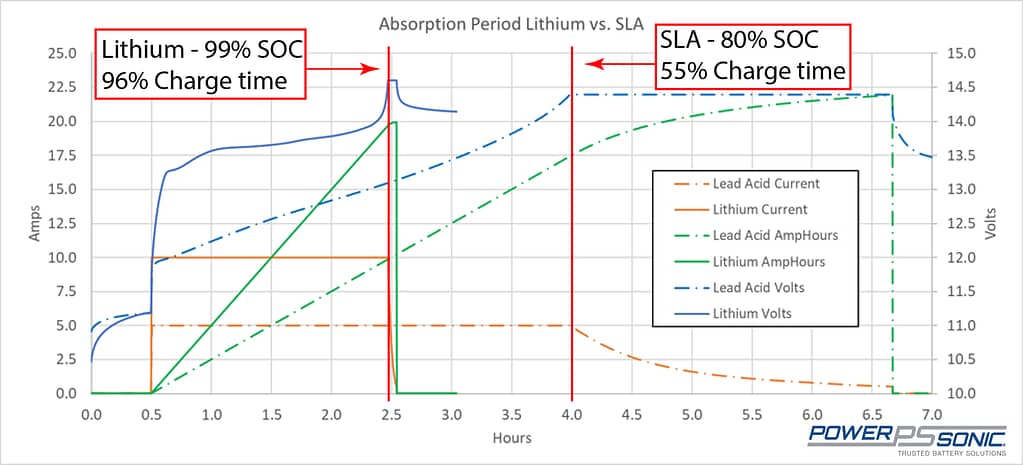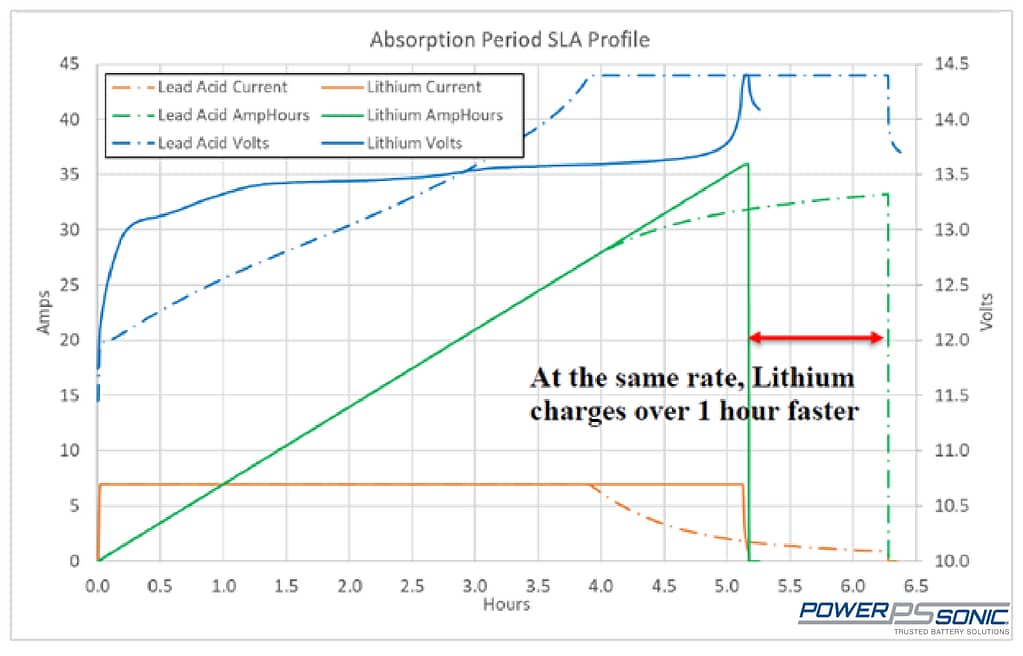Can I Charge a Lithium Battery with a Normal Charger?
One of the biggest advantages to lithium batteries is their faster charging capabilities versus their sealed lead acid counterparts. You may have heard time and time again that lithium batteries charge very quickly, but exactly how quickly, and how much faster than SLA? What does this mean for you, the end user? And, ultimately, can you charge a lithium battery with a normal sealed lead acid charger?
Charging Absorption Differences between SLA and Lithium
If you’ve ever had to wait around for an SLA battery to finish charging before you can use it in a device, you know that this is incredibly time consuming. For example, in the chart below we charged a 12-volt 20-amp hour deep cycle SLA battery, which took about 6.5 hours to reach 100% State of Charge (SOC). But, the 12.8-volt 20-amp hour lithium iron phosphate battery took just over 2.5 hours to reach 100% SOC.

In a charging cycle for SLA, there are three stages: constant current, constant voltage, and float charging. In the constant current stage, the battery is getting its bulk charge. In the 20Ah deep cycle SLA battery charging example above, the SLA battery has reached a State of Charge (SOC) of 80% during this phase – which is just over half of the total charging time. The constant voltage charge, which can also be called the absorption charge, charges the remaining 20% of the battery but also takes approximately 50% of the total charge time. Additionally, the battery should be kept on a float charge for most applications to prevent the battery from going into an over-discharged state due to self-discharging of the chemistry.
However, in a charging cycle for lithium, there are only two stages: constant current and constant voltage. In the constant current/bulk charging stage, the battery can absorb 99% of it’s capacity (SOC of 99%) in 96% of the charge time. This means in the 12.8V 20AH lithium battery example above, the battery reaches nearly 100% SOC in just under two hours. The constant voltage charge stage only provides an additional 1% to the capacity with only 4% of the charge time. Additionally, lithium batteries do not need to be kept on float charges because the lower self-discharge rate of the battery.
In this comparison, the lithium battery has been fully charged before the SLA battery even reaches the constant voltage stage of its charging cycle, and charges in 1/3 the time of the SLA battery. This is especially important in highly cyclic applications where a device will be out of service for charging. In larger SLA batteries, the extended charging time may require extra batteries to be in use while some batteries charge.
Lithium Absorption on an SLA Charging Profile
Understanding how Lithium and SLA charging profiles work, you may have questions about what would happen during charge if you were to use a lithium battery as a drop-in replacement where an SLA battery charger was used? Would this damage the battery? Will the lithium battery tolerate the voltage differences and float charging?
When charging a lithium battery on an SLA charger with a 13.8v bulk charge (the typical float voltage for SLA and a common voltage for simple chargers), it reaches 95% capacity in about 90% of the total charging time. This means the last 5% of capacity is absorbed in 10% of float charging time. If this lithium battery were charged on a 14.6V bulk charge (typical constant voltage for charging an AGM battery – chosen because lithium is usually a drop-in replacement for AGM batteries), it would have absorbed 99% capacity in 95% of the total charge time, meaning the last 1% of charge is absorbed in the last 5% of charge time.
The charge time will be increased when charging lithium on an SLA profile – from about 2.5 hours in the 20AH lithium battery charged on a lithium profile above to about 5 hours for the same battery on the SLA profile. As you can see in the chart below, this means the lithium battery still charges in less time than it would take for the equivalent SLA battery to charge on an SLA profile.

So, can you use lithium in an SLA charger? Yes, as long as that charger does not have a de-sulfation mode or a dead battery detector. For reference, the de-sulfation function on SLA chargers is to bring back an over-discharged SLA battery by using low amps and high voltage pulses. This de-sulfation mode can cause a lithium battery BMS to shut the battery down, or even damage the battery due to the high voltage pulse. Additionally, the dead battery detector might interpret a lithium battery that has gone into protection mode as a dead battery, and may not be able to get the lithium battery out of protection.
As mentioned in this blog, SLA charging profiles feature a voltage of 13.8 to 14.7. In this range, you can expect to see the fuller capacity charging benefits of using a lithium battery. The lithium battery will always reach 100% state of charge much faster than the SLA equivalent, especially in higher voltages as lithium charges at 14.6 volts. At the lower end of the voltage range, the lithium battery will still reach 95% SOC faster than the SLA battery reach 80% SOC. At the high end of the voltage range, used for most AGM batteries, the lithium battery will be 100% charged.
Will a normal SLA charger damage a lithium battery?
Lastly, will it damage a lithium battery if you use an SLA battery charger? Assuming the charger does not have a de-sulfate mode, in highly cyclic applications where the battery is being cycled daily and it may not ever see the float charge, you will not likely see any degradation. You may also not reach full capacity of the lithium battery using the SLA charger (a 20AH lithium battery may not reach 20 amps on an SLA charger, for example). If you won’t be using the battery often and it will see a large amount of time on a float, it would be better to disconnect the battery from the charger before storage. As a side note, lithium does best when stored at 50% SOC. But, in short, you can use a normal SLA charger (without the de-sulfate mode) to charge a lithium battery.
Power Sonic does recommend charging batteries with a charger suitable for their chemistry. We also recommend checking all lithium batteries for low voltage every 3-4 months and charging as needed. For our full lithium maintenance recommendations, please click here.
For more information on lithium and SLA charging profiles of lithium and SLA batteries, please visit this blog post to learn more.







